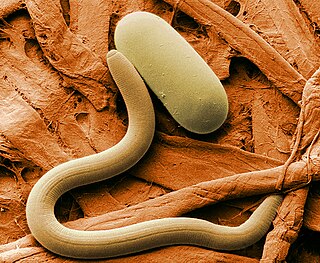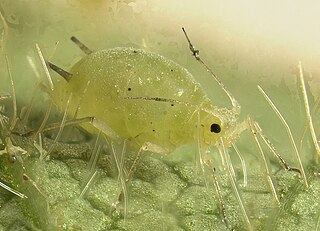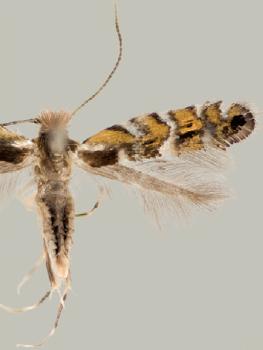
The soybean, soy bean, or soya bean is a species of legume native to East Asia, widely grown for its edible bean, which has numerous uses.

Rhizobia are diazotrophic bacteria that fix nitrogen after becoming established inside the root nodules of legumes (Fabaceae). To express genes for nitrogen fixation, rhizobia require a plant host; they cannot independently fix nitrogen. In general, they are gram negative, motile, non-sporulating rods.

The soybean cyst nematode (SCN), Heterodera glycines, is the most devastating pest to soybean crop yields in the U.S., targeting the roots of soybean and other legume plants. When infection is severe SCNs cause stunting, yellowing, impaired canopy development, and yield loss. The symptoms caused by SCNs can go easily unrecognized by farmers—in some cases there are no warning symptoms before a loss of 40% of the yield. Due to the slight stunting and yellowing, many farmers may mistake these symptoms as environmental problems when in fact they are SCNs. Another symptom of SCNs that may affect farmers' yields is stunted roots with fewer nitrogen-fixing nodules. Due to the fact that soybean cyst nematodes can only move a few centimeters in the soil by themselves, they mostly are spread via tillage or plant transplants. This area of infection will look patchy and nonuniform making diagnosis more difficult for farmers. They can be seen in the roots of summer soybean plants if the roots are taken out very carefully and gently washed with water. The egg masses should be seen as bright white or yellow "pearls" on the roots. The later the roots are pulled the harder it will be to diagnose due to the SCNs female dying and turning a much darker color, forming a "cyst". The best way to know if a field is infected by soybean cyst nematodes is to take a soil sample to a nematologist.
A trypsin inhibitor (TI) is a protein and a type of serine protease inhibitor (serpin) that reduces the biological activity of trypsin by controlling the activation and catalytic reactions of proteins. Trypsin is an enzyme involved in the breakdown of many different proteins, primarily as part of digestion in humans and other animals such as monogastrics and young ruminants. Serpins – including trypsin inhibitors – are irreversible and suicide substrate-like inhibitors.

Sclerotinia sclerotiorum is a plant pathogenic fungus and can cause a disease called white mold if conditions are conducive. S. sclerotiorum can also be known as cottony rot, watery soft rot, stem rot, drop, crown rot and blossom blight. A key characteristic of this pathogen is its ability to produce black resting structures known as sclerotia and white fuzzy growths of mycelium on the plant it infects. These sclerotia give rise to a fruiting body in the spring that produces spores in a sac which is why fungi in this class are called sac fungi (Ascomycota). This pathogen can occur on many continents and has a wide host range of plants. When S. sclerotiorum is onset in the field by favorable environmental conditions, losses can be great and control measures should be considered.
Colletotrichum glycines is a species of fungus in the family Glomerellaceae. It is a plant pathogen, causing soybean and tomato anthracnose. It is the teleomorph form of Glomerella glycines.
Paratylenchus minutus is a plant pathogenic nematode infecting pineapples. It's very small only being 0.24–0.31 mm long. It is found in Hawaii, Florida, and China.

Paratylenchus hamatus, the fig pin nematode, is a species of migratory plant endoparasites, that causes lesions on plant roots resulting in symptoms of chlorosis, wilting and ultimately yield losses. They move and feed on different parts of host tissue throughout their life cycle in order to find enough susceptible host tissue to survive and reproduce. A wide range of host plant species are susceptible to the fig pin nematode, including many valuable fruit and vegetable crops such as figs, carrots and celery. They are also commonly found associated with woody perennials in California. P. hamatus inhabits soils in both Europe and North America, and was originally isolated from fig in central California in 1950.
Paratylenchus macrophallus is a plant pathogenic nematode infecting mint.
Paratylenchus tenuicaudatus is a plant pathogenic nematode infecting soybeans.
Paratylenchus is a genus of nematodes. Many of the species in this genus are plant pathogens.

Maruca vitrata is a pantropical insect pest of leguminous crops like pigeon pea, cowpea, mung bean and soybean. Its common names include the maruca pod borer, bean pod borer, soybean pod borer, mung moth, and the legume pod borer. The species was first described by Johan Christian Fabricius in 1787.

The soybean aphid is an insect pest of soybean that is exotic to North America. The soybean aphid is native to Asia. It has been described as a common pest of soybeans in China and as an occasional pest of soybeans in Indonesia, Japan, Korea, Malaysia, the Philippines, and Thailand. The soybean aphid was first documented in North America in Wisconsin in July 2000. Ragsdale et al. (2004) noted that the soybean aphid probably arrived in North America earlier than 2000, but remained undetected for a period of time. Venette and Ragsdale (2004) suggested that Japan probably served as the point of origin for the soybean aphid's North American invasion. By 2003, the soybean aphid had been documented in Delaware, Georgia, Illinois, Indiana, Iowa, Kansas, Kentucky, Michigan, Minnesota, Mississippi, Missouri, Nebraska, New York, North Dakota, Ohio, Pennsylvania, South Dakota, Virginia, West Virginia, and Wisconsin. Together, these states accounted for 89% of the 63,600,000 acres (257,000 km2) of soybean planted in the United States in 2007.

Glycine soja, known as wild soybean, is an annual plant in the family Fabaceae. It may be treated as a separate species, the closest living relative of the cultivated soybean, Glycine max, an important crop, or as a subspecies of the cultivated soybean, Glycine max subsp. soja.

Bradyrhizobium japonicum is a species of legume-root nodulating, microsymbiotic nitrogen-fixing bacteria. The species is one of many Gram-negative, rod-shaped bacteria commonly referred to as rhizobia. Within that broad classification, which has three groups, taxonomy studies using DNA sequencing indicate that B. japonicum belongs within homology group II.

Macrosaccus morrisella is a moth of the family Gracillariidae. In North America it is known from Manitoba, Ontario, and Quebec, south and west to Texas and Colorado.
Glyceollins are a family of prenylated pterocarpans found in ineffective types of nodule in soybean in response to symbiotic infection.
Ensifer fredii is a nitrogen fixing bacterium. It is a fast-growing root nodule bacterium. Ensifer fredii exhibits a broad host-range and is able to nodulate both determinant hosts, such as soy, as well as indeterminate hosts including the pigeon pea. Because of their ease of host infection there is interest in their genetics and the symbiotic role in host infection and nodule formation.

Piezodorus guildinii, known generally as red-banded stink bug, is a species of stink bug in the family Pentatomidae. Other common names include the small green stink bug and alfalfa bug.









